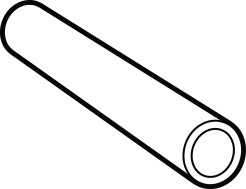
Round tube and pipe are extruded products that are widely used for all types of fabrication projects where lightweight and corrosion resistance is a primary concern. The interior is smooth with no seam and is available in an extruded structural or a drawn seamless round tube for higher-precision applications.
| Grade | Description |
|---|---|
| A106 | Pressure tested. Ideal for high-temperature environments. Suitable for bending, flanging and similar forming operations. |
| A500 Gr-B | Standard specification published by the ASTM for cold-formed welded and seamless carbon steel structural tubing in round, square, and rectangular shapes. |
| A53 | Carbon steel pipe that covers seamless and welded black and hot-dipped galvanized steel pipe. It is used in pressure and mechanical applications and in steam, water, gas, and air lines. |
| CDS/HFS A519 | Good machinability, mechanical tubing great for tubes requiring thicker walls for high pressure and heavy duty applications. |
| DOM 1020 | Low hardenability and low tensile carbon steel. It has high machinability, high strength, high ductility and good weldability. |
| DOM 1026 | Nonresulfurized carbon steel. |
| SAE J252 | Welded and seamless steel pipe, in which the steel cylinder acts as a permanent load carrying member. |
| SAE J524 | Seamless, low carbon steel tubing. Annealed for bending. One of the easiest to bend. |
| Grade | Description |
|---|---|
| 4130 | General purpose alloy. Offers good strength and toughness for moderately stressed parts. |
| 4140 | Medium carbon steel that is widely used for general purposes. Good hardenability, strength, toughness, wear resistance, and ductility. |
| Grade | Description |
|---|---|
| 3003 | Most widely used of all aluminum alloys. Excellent corrosion resistance and good workability. Added manganese to increase strength 20% more than 1xxx grade. |
| 6061, 6063 | Heat treatable, structural alloy with medium strength and good weldability, formability, machinability, and relatively good corrosion resistance. |
| Grade | Description |
|---|---|
| 201 | Lower and more stable cost due to the substitution of lower cost manganese and nitrogen. This is a less expensive option, with good resistance to corrosion and tarnishing. |
| 304 | Offers resistance to corrosion, has good formability and can be readily welded by all methods. One of the most commonly used grades across the industry. |
| 304L | Extra low carbon avoids harmful carbide precipitation due to welding. Same corrosion resistance as 304 with lower mechanical properties. |
| 316 | Better pitting and corrosion resistance than 304, as well as higher strength at elevated temperatures. 316 can be used for valves, marine equipment, pumps, and chemical equipment. |
| 316L | Extra low carbon avoids harmful carbide precipitation due to welding. Same excellent corrosion resistance as 316. It exhibits the same high strength, toughness and workability as 304 alloys. |